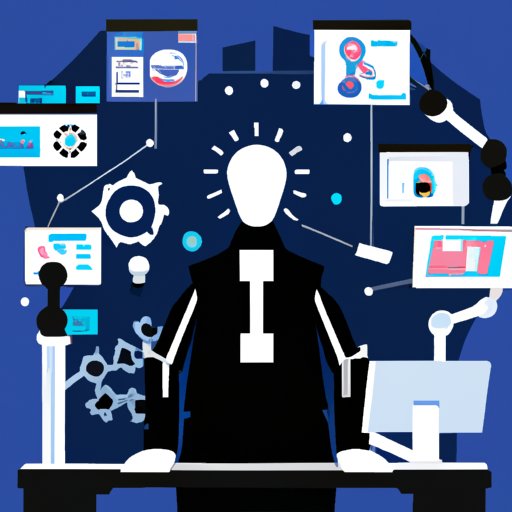Introduction
From cloud computing to artificial intelligence (AI), the use of technology in the workplace has grown exponentially over the past decade. But what does this mean for businesses and their employees? In this article, we’ll explore how technology has changed the workplace and examine the impact it has had on productivity, communication, and the nature of work.

Examining the Impact of Technology on Workplace Productivity
The introduction of new technologies such as automation and robotics has revolutionized the way businesses operate. According to a 2018 report by McKinsey Global Institute, automation could potentially increase labor productivity by up to 30 percent, resulting in an estimated $2 trillion annual boost to the global economy.
Automation and robotics have allowed businesses to streamline processes and reduce costs. For instance, machines are now being used to perform mundane tasks such as data entry and customer service, freeing up human resources for more complex and creative tasks. This is especially beneficial for small businesses, which often lack the financial resources to hire additional staff.
Technology has also enabled businesses to increase efficiency by reducing errors and improving accuracy. AI-enabled software can analyze large amounts of data quickly and accurately, allowing businesses to make informed decisions faster than ever before.

Exploring How Technology Has Transformed Communication in the Workplace
The introduction of online collaboration tools has made it easier for businesses to communicate with colleagues, customers, and partners. Cloud-based software such as Slack and Microsoft Teams allows teams to share documents, collaborate on projects, and stay connected no matter where they are in the world.
In addition to improving connectivity, technology has enabled businesses to communicate in real-time. Instant messaging apps such as WhatsApp and Skype allow people to exchange messages instantly, eliminating the need for lengthy emails or phone calls. This not only saves time but also helps to improve the quality of communication.

Analyzing the Benefits and Drawbacks of Technology in the Workplace
While technology has revolutionized the way businesses operate, there are both benefits and drawbacks to consider. On one hand, technology has increased productivity and efficiency, enabling businesses to do more with less. On the other hand, it has also resulted in a skills gap, as employers struggle to find qualified candidates with the right mix of technical and soft skills.
In addition, technology has created potential risks such as cyber security threats. As businesses become increasingly reliant on technology, they must be aware of the potential vulnerabilities and take steps to protect their data and systems.
How Technology Is Changing the Nature of Work
Technology has also had a significant impact on the nature of work. Traditional office jobs are becoming increasingly obsolete as more businesses embrace remote working and flexible schedules. According to a 2017 survey by FlexJobs, 79 percent of respondents reported that technology had improved their ability to work remotely.
In addition, technology has enabled businesses to offer flexible working hours and arrangements. This has led to an increase in freelance and contract work, as well as a shift away from traditional 9-to-5 jobs. By providing employees with greater autonomy, businesses are able to attract and retain top talent.
Investigating the Role of Automation and Robotics in the Workplace
The rise of automation and robotics has had a profound impact on the workplace. Automated systems are being used to perform a range of tasks, from customer service to data analysis. While this has improved productivity, it has also raised concerns about potential job losses.
According to a 2019 report by the Brookings Institution, up to 25 percent of American jobs could be replaced by automation over the next decade. This could have serious social and economic implications, as millions of people are forced to find new ways to earn a living.
Conclusion
The introduction of technology has transformed the workplace in many ways, from increased productivity to improved communication. However, it has also brought with it a range of challenges, from skills gaps to potential job losses. As businesses continue to embrace technology, it is important to consider both the benefits and drawbacks, as well as the implications for the future of work.
(Note: Is this article not meeting your expectations? Do you have knowledge or insights to share? Unlock new opportunities and expand your reach by joining our authors team. Click Registration to join us and share your expertise with our readers.)
